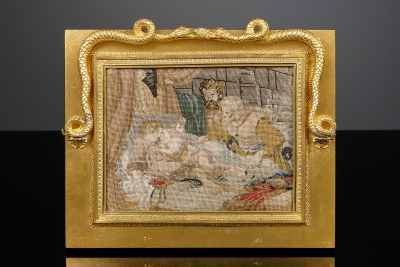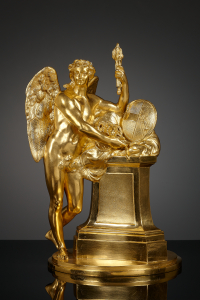Russian Empire paperweight
Russian Empire paperweight
A gilt bronze paperweight in the form of a flat-lying frame containing a delicate silk embroidery rendition of the murder of the king’s sons. To the left and right of the embroidered scene, which is enclosed within a decorated raised border, are the attachment points of a handle in the shape of two elegant serpents whose gaping jaws meet around a fruit in the middle.
When King Edward IV died in April 1483, his sons—the twelve-year-old Edward V and the nine-year-old Richard—were by all rights his heirs. However, the intervention of their uncle Richard changed everything. Travelling to meet Edward V and his entourage on the road from Wales to London, he whisked the young king off to the Tower of London, which served as a palace at the time. Edward’s younger brother soon joined him in the Tower, letting Richard proceed with the announcement that he would assume the mantle of kingship. He had his brother’s marriage declared invalid on the grounds of bigamy, which made the young princes bastards and, therefore, unfit for the throne. It is commonly believed that they were subsequently murdered in the tower under nebulous circumstances, with Richard himself as the leading suspect. On 6 July 1483, Richard was crowned King Richard III of England in Westminster Abbey.
Due to the absence of any trace or evidence of the princes and their presumed murder, the circumstances surrounding Richard III’s kingship remain mysterious and contentious to this day. This was what inspired William Shakespeare to write The Tragedy of Richard the Third in 1592-95, in which he portrayed the king as a power-hungry, corrupt sadist. In turn, Shakespeare’s tragedy became a source of inspiration for many other artists, such as Ferdinand Theodor Hildebrandt (1804-1874), who painted a scene in 1836 that shows the two boys peacefully asleep while two men approach with a pillow. This painting is still on display as part of the Spiegel collection in Halberstadt, and was frequently copied in the nineteenth and twentieth centuries. The embroidery on the paperweight, too, is a direct copy from Hildebrandt’s painting.
The handle, meanwhile, may be interpreted as symbolising the power struggle between the future king Richard III on one side and his brother and his progeny on the other. The two snakes thus represent the two powerful families: matched in strength, they fight over the apple or pine cone which they both have gripped in their jaws. The fruit in the middle is likely a reference to the apple of Adam and Eve, which represents an irresistible yearning for the forbidden. For Adam and Eve, the apple directly represented that desire, as it was the apple itself they were forbidden to eat. Here, the apple stands for the crown, and—via reference to the power that came with Adam and Eve’s knowledge of good and evil—also directly represents the power that comes with the crown, and the two parties that fought over it.
An archival discovery
A recent discovery in archival records kept in Gelderland has shed new light on the case of the princes vanished in 1483. In November 2023, the historian Philippa Langley—who was responsible for the discovery of Richard III’s skeleton under a parking lot in Leicester—launched a book and a documentary in which she presents an entirely different version of events. She claims that the princes were not murdered at all, but were taken to safety elsewhere in Europe. This would mean that the skeletons found under a staircase in the Tower of London in the seventeenth century are not those of the royal brothers. Buried in a stately tomb in Westminster Abbey, the bones were never DNA-tested, and requests to conduct such tests were rejected by Buckingham Palace and the Church of England.
Langley’s new study alleges that the princes were separated and raised in Europe, and that they attempted to reclaim the English throne many years later. Her findings are based on documents found in European archives by researchers, one of which is a purported witness statement in the Gelders Archief (the Archives of Gelderland). In it, the younger prince—Richard of York—allegedly describes in detail how he was smuggled from the Tower at the age of nine. Experts have confirmed that the age of the document matches the timeframe.
- Period
- ca. 1840
- Material
- fire-gilt bronze, silver embroidery with metal beads
- Dimensions
- 20.5 x 25 cm
Global shipping available







